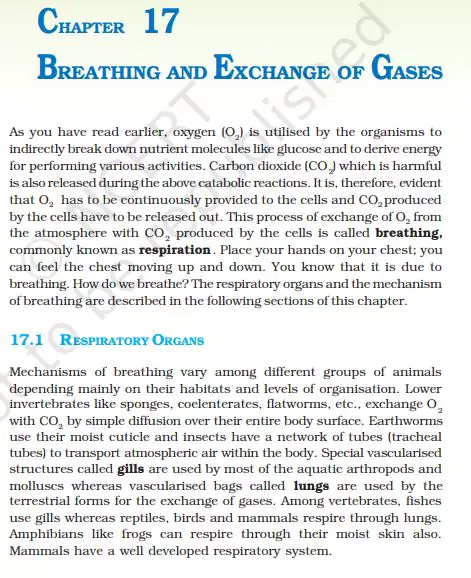‘NCERT Solutions for Class 11 Biology Chapter 17 Breathing and Exchange of Gases’ PDF Quick download link is given at the bottom of this article. You can see the PDF demo, size of the PDF, page numbers, and direct download Free PDF of ‘Ncert Class 11 Biology Chapter 17 Exercise Solution’ using the download button.
Breathing and Exchange of Gases NCERT Textbook With Solutions PDF Free Download

Chapter 17: Breathing and Exchange of Gases
As you have read earlier, oxygen (O2 ) is utilized by organisms to indirectly break down nutrient molecules like glucose and to derive energy for performing various activities. Carbon dioxide (CO2) which is harmful is also released during the above catabolic reactions.
It is, therefore, evident that O2 has to be continuously provided to the cells, and CO2 produced
by the cells has to be released out.
This process of exchange of O2 from the atmosphere with CO2 produced by the cells is called breathing, commonly known as respiration. Place your hands on your chest; you can feel the chest moving up and down.
You know that it is due to breathing. How do we breathe? The respiratory organs and the mechanism of breathing are described in the following sections of this chapter.
17.1 RESPIRATORY ORGANS
Mechanisms of breathing vary among different groups of animals depending mainly on their habitats and levels of organization.
Lower invertebrates like sponges, coelenterates, flatworms, etc., exchange O2 with CO2 by simple diffusion over their entire body surface.
Earthworms use their moist cuticle and insects have a network of tubes (tracheal tubes) to transport atmospheric air within the body.
Special vascularised structures called gills are used by most aquatic arthropods and mollusks whereas vascularised bags called lungs are used by the terrestrial forms for the exchange of gases.
Among vertebrates, fishes use gills whereas reptiles, birds, and mammals respire through lungs.
Amphibians like frogs can respire through their moist skin also. Mammals have a well-developed respiratory system.
17.1.1 Human Respiratory System
We have a pair of external nostrils opening out above the upper lips. It leads to a nasal chamber through the nasal passage. The nasal chamber opens into the pharynx, a portion of which is the common passage for food and air.
The pharynx opens through the larynx region into the trachea. The larynx is a cartilaginous box that helps in sound production and is hence called the soundbox.
During swallowing glottis can be covered by a thin elastic cartilaginous flap called epiglottis to prevent the entry of food into the larynx.
The trachea is a straight tube extending up to the mid-thoracic cavity, which divides at the level of the 5th thoracic vertebra into a right and left primary bronchi.
Each bronchus undergoes repeated divisions to form the secondary and tertiary bronchi and bronchioles ending up in very thin terminal bronchioles.
The tracheae, primary, secondary and tertiary bronchi, and initial bronchioles are supported by incomplete cartilaginous rings.
Each terminal bronchiole gives rise to a number of very thin, irregular-walled, and vascularised bag-like structures called alveoli.
| Author | NCERT |
| Language | English |
| No. of Pages | 10 |
| PDF Size | 887 KB |
| Category | Biology |
| Source/Credits | ncert.nic.in |
NCERT Solutions Class 11 Biology Chapter 17 Breathing and Exchange of Gases
1. Define vital capacity. What is its significance?
Solution:
Vital capacity can be defined as the maximum volume of air a person can breathe in post a forced expiration.
Significance of vital capacity:
(i) It depicts the maximum amount of air that can be converted or renewed in the respiratory system in a single respiration
(ii) The excess quantity of inhaled air represents the maximum amount of oxygen available for glucose oxidation. This way more energy is available for the body.
2. State the volume of air remaining in the lungs after a normal breathing.
Solution:
It can be stated by the functional residual capacity (FRC). FRC is the volume of air that remains in the lungs after a normal expiration. The functional residual capacity is both the expiratory reserve volume (ERV) and residual volume (RV).
The expiratory reserve volume is the maximum volume of air that can be exhaled post a normal expiration which is approximately1000ml-1500ml. The residual volume is the volume of air that remains in the lungs after maximum expiration which is about 1100ml to 1500ml.
Hence,
FRC = ERV + RV
≅ 1500 + 1500 = 3000 ml
Thus, the functional residual capacity of the lungs in human beings is nearly 2500 ml to 3000 ml
3. How is respiration regulated?
Solution:
The medulla region of the brain having the respiratory rhythm center is chiefly responsible for the regulation process of respiration.
The function performed by the respiratory rhythm center can be altered by the pneumatic center through signals to reduce the inspiration rate.
The chemosensitive area located near the respiratory center is sensitive to hydrogen ions and carbon dioxide. This region then sends signals to alter the rate of expiration to eliminate compounds.
The levels of carbon dioxide and hydrogen ions in the blood are detected by the receptors located in the carotid artery and the aorta.
As the carbon dioxide level increases, the respiratory center sends nerve impulses for the required changes.
4. What is the effect of pCO2 on oxygen transport?
Solution:
pCO2 has a crucial role to play in the process of oxygen transport. As a result of low pCO2 levels in the alveoli, oxygen tends to bind with the hemoglobin, to form Oxyhaemoglobin.
Higher levels of pCO2 and lower level of pO2 in the tissues promotes the dissociation of oxygen from Oxyhaemoglobin.
The level of pCO2 is low at the surface of the lungs, here O2 binds with the hemoglobin and dissociates at the tissue grade, where the level of pCO2 is higher.
NCERT Class 11 Biology Textbook Chapter 17 Breathing and Exchange of Gases With Answer PDF Free Download
